The cart is empty!
Aberdeen Branch is pleased to announce the Following Events:
Aberdeen Branch is pleased to announce the Following Events
Aberdeen Branch is pleased to announce the Following Events
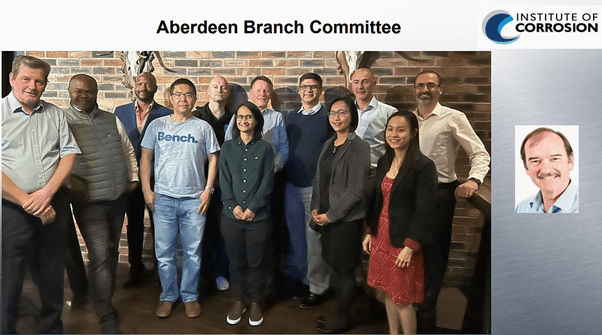
Aberdeen events coming up in October and November 2022 include:
ICorr HQ will notify all ICorr Members shortly of Event Details / Registration Details.
To join the Aberdeen Branch Mailing List, please contact: icorrabz@gmail.com
See also our Aberdeen Linkedin Page: https://www.linkedin.com/in/aberdeen-icorr/?originalSubdomain=uk
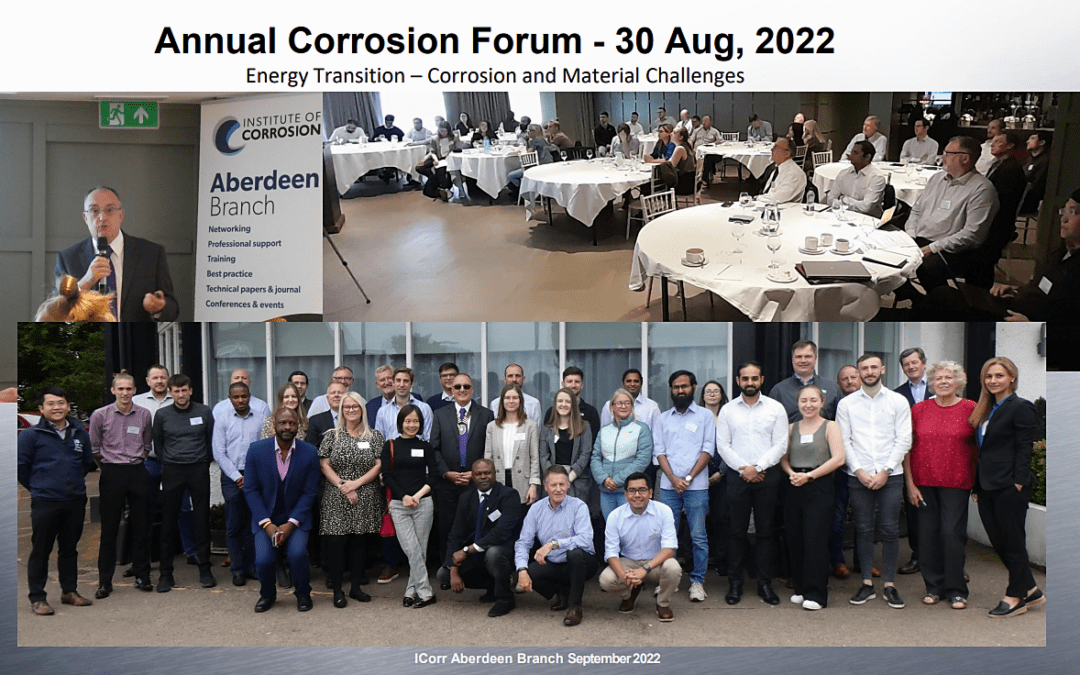
yOn Tuesday 30th August 2022, the Institute of Corrosion Aberdeen Branch held its 2022 Annual Corrosion Forum and was extremely well received. This was a comprehensive whole -day Event of Net-Zero related presentations by a range of industry experts superbly chaired on the day by Dr Olubayo Latinwo and raising nearly £3000 towards ICorr funds for future training programmes.
Presserv Ltd were the Key Sponsor for this event and during the day hosted a demonstration of their products and services, identifying what impact they could have on the energy transition market. Presserv Ltd were also kind enough to arrange the venue (Palm Court Hotel) and also provided catering services throughout the day.
The Event’s key goal was to identify materials, corrosion and asset integrity challenges we face, as we move into the new energy transition era.
ACF outcomes were an extremely useful technical insight for all Conference attendees, companies, duty holders, operators, asset managers and individuals who may wish to transition to greener solutions in the foreseeable future. Rarely are the topics of materials, corrosion and asset integrity the focus of energy transition talk’s and the Institute of Corrosion provided an excellent opportunity to prepare all for the relevant challenges ahead.
ACF Event Chair / ABZ Vice Chair
Dr Olubayo Latinwo
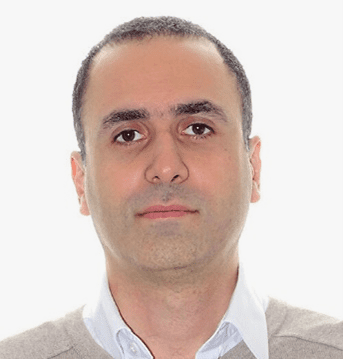
Branch Chair and Event Technical Coordinator
Hooman Takhtechian
P1 Keynote Speaker, Bill Hedges – ICorr President
Dr Bill Hedges spoke from his combined 34 years’ experience in corrosion science, integrity management and engineering and in the oil & gas industry working for Exxon and BP. He was with BP for 24 years and left in 2020 to form his own consultancy business. His final role was as the Chief Engineer for Materials and Integrity Management. He has spent half of his career working in central engineering functions and half in operational locations in many countries worldwide with specific assignments in London, Houston, Trinidad and Alaska. These assignments have given him practical experience of integrity issues in onshore, offshore, deep-water, tropical, desert and arctic environments.
Bill holds a B.Sc. in chemistry and a Ph.D. in electrochemistry (lithium batteries) from the University of Southampton, UK and spent time as a researcher in the Bioengineering department at Oxford University, UK. He is a Chartered Engineer (CEng.), Chartered Chemist (CChem) and a Fellow of both the Institute of Corrosion (FICorr) and the Royal Society of Chemistry (FRSC). He has held director roles with the National Association of Corrosion Engineers (NACE) Foundation and the NACE Europe board. He has published 38 papers and in 2009 was awarded the NACE Fellow honour (FNACE).
Muhsen Elhaddad – Former NACE Qatar Chair
Muhsen has been working as a Corrosion and Well Integrity Engineer for more than 20 years where he is responsible for designing and implementation of corrosion policies and specifications for upstream, midstream and downstream operations. During his working tenure, Muhsen has contributed a great deal towards advancing the understanding, of transforming companies towards cleaner energies. Muhsen holds a BEng and MSc in material science, engineering and technology, from University of Qatar and is currently pursuing a PhD in electrochemistry, he spoke passionately about the need to have competent and engaging corrosion and materials professionals involved at all levels of the asset cycle from conception of the project to decommissioning.
People are known to be the heart of effective asset integrity management and only people can make effective asset integrity happen with their proactive approach, flexibility and the quick response. They must be knowledgeable, have the right competency, and the authority to act on their knowledge, expertise and experience. They should have the means to collaborate, share and communicate at all levels of the organization and take pride in their profession. This also requires change in mind set and understanding that a job is not for a salary it is a profession that a corrosion professional need to embrace and practice fully.
P3 Frank Cheng – University of Calgary
Dr. Frank Cheng is a Professor and Canada Research Chair in Pipeline Engineering at the University of Calgary. Frank is an internationally recognized researcher in Energy Pipeline Technology, specializing in pipeline corrosion and cracking, integrity management, and new energy transport systems. His talk provided technical background about hydrogen embrittlement (HE), detailing unique features of the problem associated with high-pressure gaseous environments and the additional challenges of the conversion of existing “aged” gas pipelines for hydrogen service. These include corrosion and mechanical defects serving as hydrogen traps, pre-strain induced by pipe-soil interaction to increase the HE susceptibility, competitive adsorption of impurity gases with hydrogen gas on steel surface, and preferential accumulation of hydrogen atoms and the resulting cracking at pipeline welds.
Technical gaps were analysed, and recommendations provided for both research community and industry to develop a technical assessment program for the suitability of existing pipelines for hydrogen transport. Hydrogen, as a green and zero-emission fuel, has received wide attention recently. Hydrogen delivery is integral to the entire value chain of hydrogen economy, where pipelines provide an economic and efficient means to transport hydrogen.
P4 Shravan Kairy – NPL
Dr Shravan Kairy is a Higher Research Scientist at National Physical Laboratory, UK. His current research is focused on understanding the corrosion of pipeline steels in dense phase CO2 and developing a standard test method. In his presentation, Shravan provided a comprehensive overview of the most common experimental methodologies used to assess corrosion of pipeline steels in dense phase CO2. Key factors that influence corrosion of pipeline steels in dense phase CO2 during service and the challenges of incorporating these factors into experimental methodologies were discussed. The current industry understanding of corrosion of pipeline steels in dense phase CO2 and recommendations on future directions was also provided.
Transportation of carbon dioxide (CO2) is essential for the storage of captured anthropogenic CO2 at dedicated locations, such as depleted oilfields. Pipeline transport of dense phase CO2, i.e., in the liquid or supercritical phase, enables cost effective high throughput transport. Understanding the factors controlling corrosion of pipeline steels in the dense phase CO2 environment is necessary for qualifying pipeline materials for service and establishing reliable and cost-effective impurity threshold specifications.
P5 Anthony Setiedi – Wood Thistled
Dr. Setiadi FICorr has a strong track record of delivering technical and project management roles throughout 20 years in the industry and academia. His work has primarily been in the offshore oil and gas industry prior to the transition to offshore wind. He is currently the Chief Consultant at Wood Thilsted where he is responsible for the corrosion protection design for numerous offshore wind developments in the UK, Europe and USA. He argued that a corrosion protection strategy needs to be developed and agreed well in advance, which then needs to be followed through to completion, including input to Operation and Maintenance Strategy to ensure that structural integrity is not compromised throughout design life.
This presentation primarily focussed on monopile foundations and the design considerations that would need to be taken onboard. Monopiles have both internal and external surface needing protection. Much thought must be given to the level of protection needed and consideration of the impact to structural integrity throughout the design life, and how fabrication, transport and installation limitations would affect the corrosion protection design. Coating requirements and different cathodic protection systems (i.e. Galvanic and ICCP) were discussed for the internal and external challenges regarding positioning of the CP system and installation concerns that need to be taken into account offshore during the installation phases.
P6 Simon Daly – Safinah Group
Simon Daly B.Eng (Hons) is an AMPP-certified Senior Corrosion technologist and a professional member of ICorr with over 30 years’ experience in the protective coatings field and a consultant with Safinah. His talk highlighted how Corrosion issues within existing fixed wind turbine facilities have necessitated coating requirements more extensive than previously foreseen. Different long term performance requirements, couples with increased productivity to meet offshore renewables targets means that coating selection must be very carefully considered especially with the increasing number of Floating structures.
Offshore wind turbine structures are exposed to environments with high salinity, high levels of UV radiation, the presence of cathodic protection and other factors such as tidal influences. As well as the offshore turbines themselves, larger offshore structures such as transformer stations may have more extensive coating requirements including the need for passive fire protection. As the industry transitions to floating structures designs may also have the challenges associated with marine fouling as well as more extensive coating work scopes.
P7 Joven Lim – UK Atomic Energy Authority
Joven Lim BEng (Hons), DPhil (Oxon), MIMMM, MInstP is a core member of Reactor Chemistry and Materials Research Working Group of GE Hitachi Nuclear Energy, an experienced nuclear materials scientist with an engineering background. He gave an overview of the Tokamak-type fusion reactor design, the potential list of coolants can be used and why, and the expected corrosion challenges from the extreme environment in the fusion reactor. The speaker also provided some insights on the criteria used for materials selection, corrosion management & mitigation strategy currently being developed for UK STEP fusion programme that aim to deliver a prototype fusion energy plant, targeting 2040 [https://step.ukaea.uk/].
With the increase of national interest to focus on developing and deploying clean energy and ensuring a good energy mix for the future, Fusion power plant is one of the ideal candidates. Fusion reactors do not generate carbon dioxide or other greenhouse gases into the atmosphere. Its major by-product is helium gas. Nuclear fusion reactors do not produce high activity, long-lived nuclear waste. The recent record-breaking 59 megajoules of sustained fusion energy demonstrates potential of fusion to be part of the future energy mix at world-leading Joint European Torus facility, a Tokamak-type fusion reactor design, in Oxford, UK [https://www.euro-fusion.org/news/2022/european-researchers-achieve-fusion-energy-record/].
P8 Frederick Pessu – University of Leeds
Dr Frederick Pessu is Lecturer in Corrosion, and is based Institute of Functional Surfaces, University of Leeds. He holds a B.Eng degree in chemical engineering, MSc. (Eng) and PhD in Corrosion Engineering and has been working in the areas of corrosion science and engineering since 2009. His research interests have been focused on fundamental understanding and characterisation of material performance in arduous corrosion systems, including renewable and low carbon energy production systems that support energy de-carbonisation, e.g. 1. Molten salts corrosion in Concentrated Solar Power Generation Plants (CSP) and Molten Salt Reactors (MSR). 2. Pitting and overall corrosion in CO2/H2S – containing energy systems; including high scaling geothermal systems.
His presentation highlighted the corrosion challenges in the new frontier of low carbon and renewable energy generation; Solar and nuclear energy sources have shown the greatest promise in our efforts to meet global climate change target. Electricity generation from solar and nuclear irradiation can be achieved using concentrated solar power (CSP) technologies and Gen IV molten salt nuclear reactors (MSR).
P9 Urvesh Vala – Chiyoda Ltd India
Dr Urvesh Vala is presently working as Head, Material Engineering & Technology, L&T Chiyoda LTD. India.
Cross country pipelines and plant piping play vital role for fluid, gas and water transportation which is mainly underground and protective coating with cathodic protection provides more than 25 years of corrosion protection. Protective coatings are the prime method being used globally considering the feasibility, cost and expected service life for onshore and offshore equipment and structures. Coating such as Fusion bonded epoxy, 3-layer polyethylene, polypropylene, modified epoxy, polyurethane, cold applied bituminous, polyethylene tape is most widely used coating for underground piping. Urvesh highlighted in his talk the prime factors for coating system selection – Type of material to be protected / Service temperature / Type of service i.e. open to atmosphere, under insulation, internal/immersion, buried, under fireproofing / Feasibility for maintenance of coating / Expected life.
P10 Jonathan Francis – Trac Energy
Jonathan Francis BSc. (NDT) is a practically minded individual with 3 decades of experience in non-destructive testing within the oil and gas industry with formal qualifications in 5 core NDT methods, Ultrasonics, Radiography, Eddy Current, Magnetic particle and Dye penetrant inspection. Jonathan holds a Bachelor of Science degree in NDT and is in his fourth year of a part-time PHD researching the reliability of manual ultrasonic testing.
Despite the advances and proven reliability of automated ultrasonics (AUT) Manual ultrasonic testing (MUT) is still widely relied upon in industry and has the inherent capability to detect wall loss and give quantifiable data on thickness of components with the data used to ensure plant and equipment can continue to run safely, but the current body of literature shows a host of human factors that can affect MUT performance. The use of a magnetic probe coupler (MPC) is proposed that will aid the task and the inspector in carrying out a reliable MUT inspection. It will do this by ensuring that probe coupling is maintained to the Carbon Steel surface when working in a variety of positions while improving the tactility of scanning a component. It will greatly aid the monitoring of known areas of wall loss by ensuring that the probe is coupled consistently and accurately in the same position.
The Institute of Corrosion Aberdeen Branch gratefully acknowledges the support of all participants and the ICorr HQ Admin Team. Event photos may viewed at https://1drv.ms/u/s!Ajj3m1kM8SgPrj_TTl_bylOPF1LB?e=EfsRMM
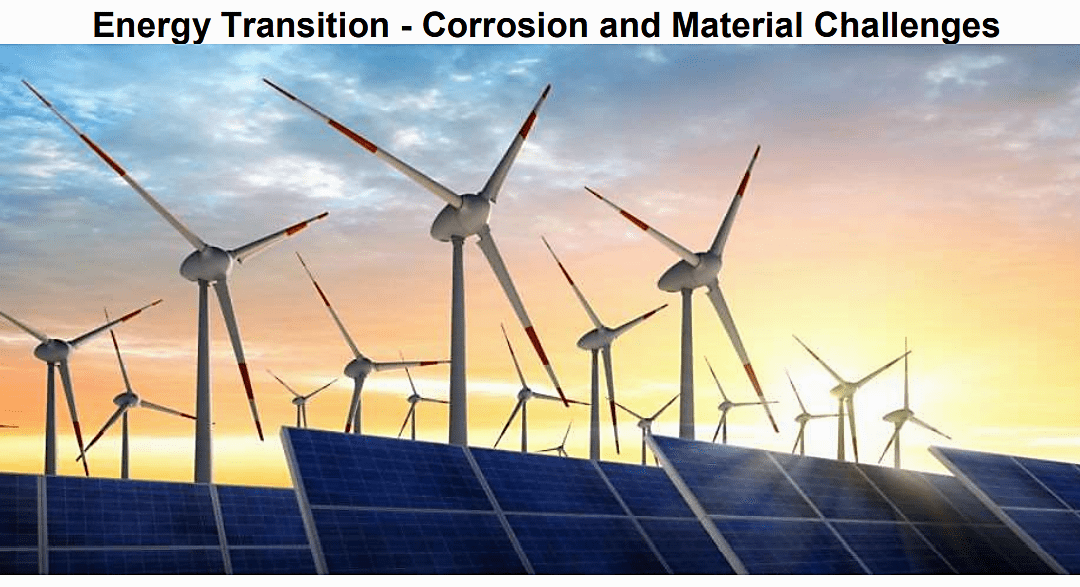
We are very pleased to announce ICORR Aberdeen’s 2022 Annual Corrosion Forum (ACF) will be held on Tuesday 30th August 2022. Please note that this year’s topic is focused on Energy Transition and Presserv Ltd https://presserv.com/uk/ are the kind sponsor of this key event. We are also proud to announce a special guest, Bill Hedges, President of the Institute of Corrosion as Keynote Speaker, (please see full day programme attached for you). For the first time, the annual corrosion forum will be a HYBRID event and can be attended in person or virtually via a Zoom.
The venue for those wishing to attend in person will be local to Aberdeen, UK and will be communicated in due course. There will be an early bird discount for those who register before* 1st August 2022. There will also be a discount for attendees who are Members of ICorr. Simply supply your membership number with your application to be eligible.
Pricing details are summarised below:
| Attendance Type |
Regular Pricing
|
ACF Early Bird*/ ICorr Member |
| In Person |
£149.99+VAT
|
£74.99+ VAT (Discount Offer) |
| Virtual | £74.99 + VAT |
£39.99 + VAT (Discount Offer) |
All proceeds will support the continued work of ICorr as a leading authority on Corrosion and provider of Corrosion Prevention resources.
If you would like to attend this event, please complete Registration form with payment and return it to admin@icorr.org. Please note that spaces to attend this event in person are strictly limited and will be allocated on a first come, first serve basis.
We trust this event information is helpful. We look forward to your attendance.
Yours sincerely
Olubayo Latinwo
ICorr Aberdeen Branch Vice Chair”
The branch held a joint technical meeting with TWI Scottish Branch on 28th September where the speaker, Matthew Beatty from Sonomatic Ltd. discussed “In-service ultrasonic tank floor inspections”.
As described below, Sonomatic have developed an advanced system of robotic instrumentation and associated test procedures which can be used to inspect storage tanks while still in service. The instrumentation can easily navigate tank floors and using ultrasonic techniques (UT), measure the remaining through floor plate thickness, detecting both product side and soil side corrosion. From this, the remaining useful life of the tank can be determined by comparing this with the minimum containment thickness criteria for the vessel.
Desludging of tanks is performed during the measurement process as it is essential that the robot has a clean surface to make the measurement, and obtain good and reliable data. This is by done by either pumping sludge away within the tank, or pumping sludge out of tanks into containers for recycling or filtering and return. The inspection process can extend to survey tank shell walls and roof, annular plates and shell to floor welds using ultrasonics techniques.
Two main ultrasonics techniques are commonly used; (1) Short-range ultrasonics (SRUT) for features such as,
• Tank floor annular plate testing
• Testing concrete coated interfaces
• Testing under pipe supports
• Tank dyke piping interfaces
• Under vessel supports
and (2), Multiplexed phased array UT (PAUT) for the shell to annular plate weld inspection, and to assess the condition of the internal and external weld (for cracking particularly).
Acoustic emission (AE) can be used to scan the floor for active corrosion prior putting the robot into the tank.
The robots deployed for the inspection are dependent on the tank media content and the accessibility. A hydraulic driven robot is used for heavy to light hydrocarbons and a mini ROV swimmer is used mainly in water tanks. Survey robots are fitted with hydraulic pumps and scrappers to remove sludge and sediment and clean the surface ready for ultrasonic work. All robots have safety systems and monitor critical items such as oxygen and nitrogen pressure through the umbilical and can automatically shut down power at alert safety levels.
For inspections, the robot is lowered through a deployment manway using a tripod and winch system to the tank bottom and connected back to the control room through a tailored sealed temporary manway cover. Finally, the tank is purged and pressurised.
The ultrasonic probes used have a range of diameters from 8mm up to 300mm total coverage and are typically arranged in an array of around 30 probes which speeds up the scanning process and makes data more reliable.
A case study was presented of a detailed in-service inspection of an 80 metre diameter tank with known corrosion. Acoustic emission was used first to check 100% of the tank for ongoing corrosion signs. With the robot deployed the sludge was displaced by suction pump and a rubber scraper to remove surface sludge.This inspection used a total of 521 scans, representing 5% coverage of tank base. The sampling methods and statistical analysis allow for limited coverage inspection so there is no need to inspect 100% of features. With the in-built ultrasonics, in this instance which used 8 transducers with amplitude variation across each transducer, the min thickness found was 4.8mm compared with the nominal thickness of 7mm, which gave an estimated remaining life of 2 years before an out of service inspection was required. After shutdown 3 years later, the floor thickness was confirmed to be 2.20 mm versus a predicted 2.53mm from in-service inspection, a <5% difference between the two methodologies which is considered an accurate and successful prediction compared with manually performed UT readings.
The accuracy of the predictive system using the in-service data illustrated that robotic inspection of the tank floor is a viable alternative to costly shutdown and out-of-service inspection.
The branch October meeting featured an interesting online talk from Professor Y. Frank Cheng. University of Calgary (UoC), entitled “Internal corrosion of pipelines: mechanisms, modelling and management”.
Internal corrosion of pipelines is a complex phenomenon, and the complexity arises from the fact that multiple chemical and electrochemical reactions occur simultaneously with numerous interrelated factors affecting the corrosion processes. A fundamental understanding of the phenomenon is essential to modelling, prediction and management of the corrosion processes, providing recommendations to industry for improved pipeline integrity management.
Currently, pipelines for oil and natural gas are the conduit for around 55% of energy transport and, despite the rise of renewables and net-zero targets, they will still be utilised for a similar amount of energy transportation when H2, CO2 and biogas gain in popularity. For oil and gas transport, the upstream ‘gathering’ pipelines which run from production to the upstream processing plants are the subject of interest here. Of course, the corrosion issues in different sectors of the pipeline system can be very different due to the product being carried and the internal environment. In upstream gathering lines within Alberta in 2019, 46% of the corrosion issues were deemed to be due to internal corrosion alone.
Multiple factors affect the corrosion process, including fluid chemistry, operating conditions and pipe geometry. To deal with the complex issues it is important that computer models take into consideration each of these factors, and study each of the key parameters, reaction chemistry, fluid hydrodynamics and configuration, so as to produce a workable model which will realistically predict the corrosion outcome.
The UoC initially developed a thermodynamic model to determine the electrochemical anodic and cathodic reactions occurring during internal corrosion of pipelines under given conditions, and the chemical reactions (for instance CO2) occurring during electrochemical cathodic (evolution of gas) and anodic reactions (at the steel oxidation). The internal corrosion involves the formation of iron carbonate scale on the surface which changes the corrosion rate. When H2S is also introduced there are competing reactions with CO2, which further complicate the outcome.
For the chemical reactions they derived the reaction equilibrium constants and for the electrochemical reactions calculated the standard electrode potentials by Gibbs free energy and determined partial reaction potentials by the Nernst equation.
Fluid hydrodynamics plays a critical role in influencing corrosion, so studies were conducted by fitting electrodes flush with the inside pipe walls at straight and angled positions to measure corrosion rate with flow and with impingement angle to the pipe wall. Other effects that were incorporated in the flow model were the inhibitive effect of the hydrocarbon oil phase and the erosive effect of inorganic sand and solids.
Another consideration for UoC modelling was the organic acid that is always part of the fluid in upstream hydrocarbon pipelines and which will attack the iron carbonate film which readily forms on the inner walls of the pipe. The scale builds faster with higher CO2 and temperature but, when the FeCO3 scale is broken locally at a defect, this leads to pitting corrosion under the scale and can lead to accelerated attack and leaks in pipeline walls. Pitting corrosion also occurs under sand layers which settle on the pipe floor from the high upstream sand concentration in the oil sand.
The final and possibly greatest issue in oil pipeline corrosion was determined as internal microbial corrosion which is believed to be responsible for ~ 40% of all internal corrosion events in pipelines. Microbial Corrosion occurs under any deposit mixture of petroleum sludge, sands, water microorganisms and corrosion. Internal operating environments encourage growth of the microbial population products. However, in the case of gas pipelines a thin layer of water condensate occurs on the chilled wall of the pipe which makes the formation of biofilms difficult and the deposit of corrosion films more favourable, so there is a competition between the two effects.
Several predictive corrosion models have been developed from the experimental studies of parameters and mathematical relationships, and these UoC models can assist in identifying critical corrosion locations, especially pitting and erosive corrosion on a long-distance pipeline, then predict the pitting corrosion rate and pitting growth rate, however corrosion mitigation and control by operators should not rely on inhibitors and biocides as they are not a totally satisfactory solution and periodic pigging is still required as main method of control in removing and reducing deposits and sludge.
This very comprehensive presentation generated much interest from the audience and many questions that were expertly responded to by the author.
Slides of technical papers for Aberdeen branch events, along with their respective Q&A’s can be found at, https://sites.google.com/site/icorrabz/ and also at Aberdeen Branch – Institute of Corrosion (icorr.org) under Local Technical Programme. A library of event recordings may also be found at:
https://www.youtube.com/results?search_query=ICorr+Aberdeen
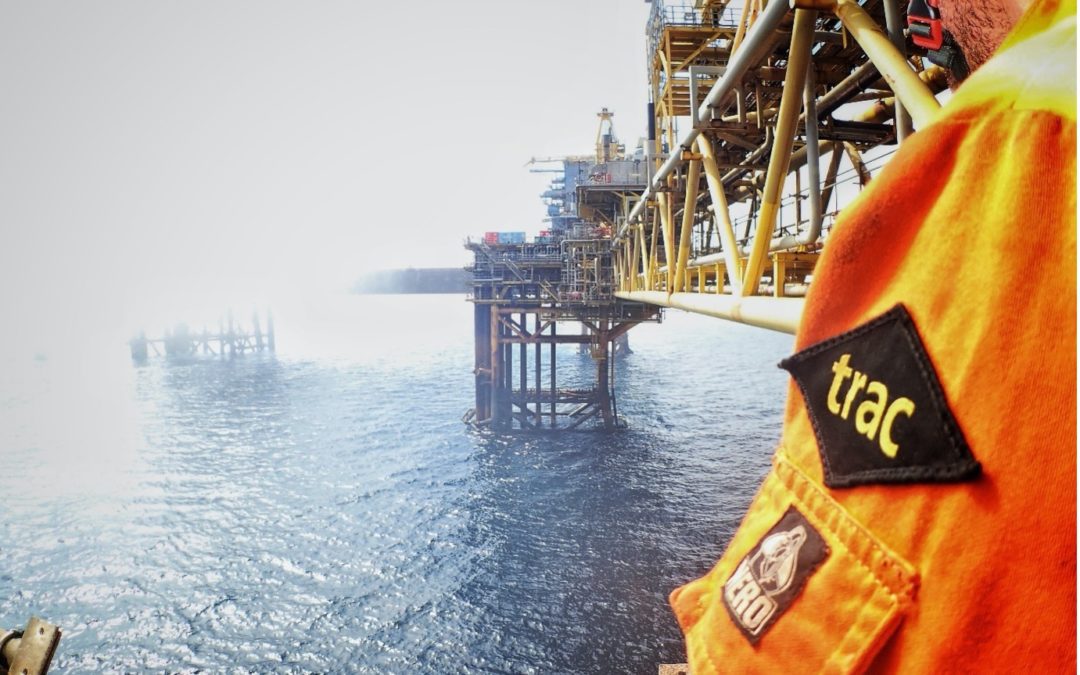
The Aberdeen Branch has several significant Events scheduled for later in the Summer and would particularly like to draw your attention to its Annual Corrosion Forum (ACF) scheduled fo 24th August. This year event is arranged to be held in TRAC Oil and Gas premises close to Aberdeen Airport.
This will be the first ICorr event in more than a year that we are going to conduct in person. The theme for the ACF this year is External Corrosion Management. The programme consists of 8 presentations to be presented by speakers from various companies, all very active in the integrity management field. Practical demonstrations in the TRAC workshops will follow in the afternoon.
Those interested in joining this Event should register your interest with ICorr HQ using the attached Form.

Notifications